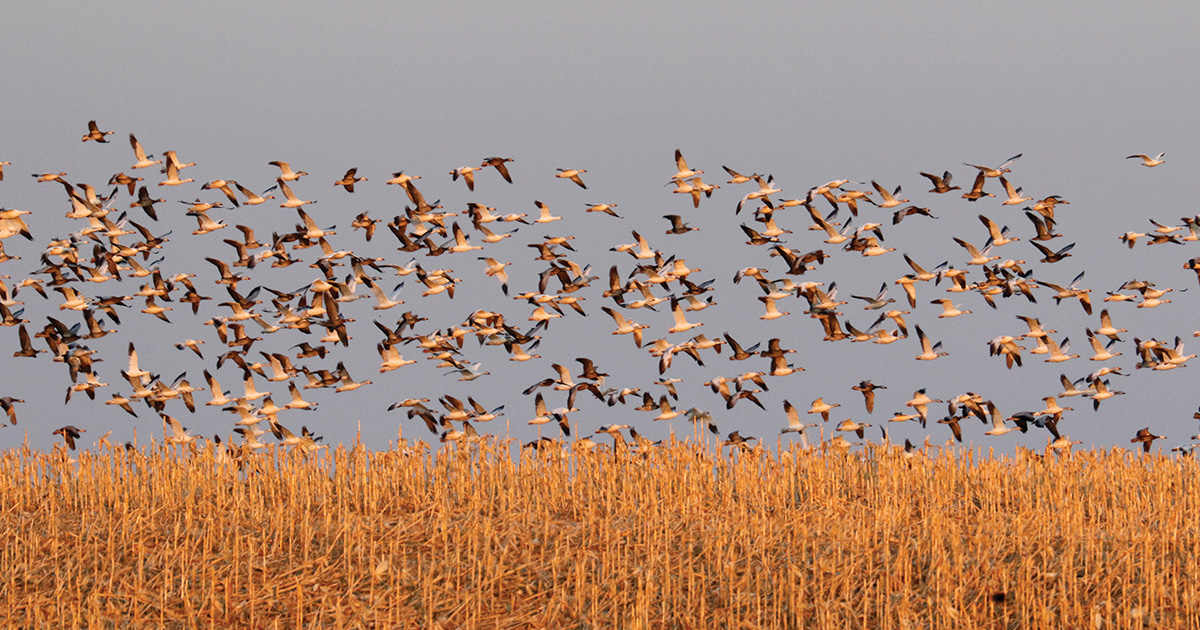Migration Alert: Light Goose Spring Migration Kicks into Overdrive
Feb. 7, 2024 – Central and Mississippi Flyway Light Goose Conservation Order
Feb. 7, 2024 – Central and Mississippi Flyway Light Goose Conservation Order

The much-anticipated 2024 Light Goose Conservation Order season is upon us, prompting a spectacular grand finale for North American waterfowl hunters. By all accounts, last summer’s hatch on the tundra was good and juvenile snow goose numbers – often the bellwether of hunting success – are very strong.
While millions of birds sought slightly warmer conditions in the deep south during January’s Arctic blast, once Mother Nature adjusted the thermostat well into the spring temperature range over the past two weeks, ducks and geese are bouncing back north in a hurry.
Arkansas is the reigning king of the February 1st Conservation Order opener, but this season many areas have far fewer birds than normal as incredible numbers of light geese have been funneling northward twenty-four-seven, probing as far north as the Iowa and South Dakota.
Presently, the main mob appears to be centered in northeast Arkansas and southeast Missouri. This entire region is under an umbrella of geese with large feeds leap-frogging their way northward, while other flocks overhead maintain proper flight levels for big jumps well into Illinois and Missouri.
Southwest Indiana and the Wabash River corridor receive an honorable mention with here today, gone tomorrow status, as geese rapidly cycle through the region into the Mississippi and Illinois River Valleys. Reports are streaming in from Illinois where strong numbers of light geese are building up in key areas.
“Lots of birds blowing through at the end of January. After the big freeze everything opened up down here including Carlysle Lake, which is holding big numbers now,” says Willow Creek Waterfowl owner Matt Albers, located in southern Illinois. “Depending on weather, we have high hopes of keeping solid numbers all of February, but 60-degree temps has these birds moving back up maybe a little faster than I’d really like to see.”
While the Bootheel of Missouri along the Arkansas border is absolutely stacked with light geese, the notorious hot spots in the north-central and far northwest of the Show Me State are filling in rapidly. Loess Bluffs NWR is currently holding well-over 500,000 snow geese, with some slowly trickling up the Missouri River Valley into Nebraska, Iowa, and South Dakota.
“The big cold front in January pushed them south a bit, but with the warm up they are rolling right back,” says Tony Vandemore, owner of Habitat Flats located in the Golden Triangle waterfowl mecca where the Grand and Missouri Rivers meet, and Swan Lake NWR, Fountain Grove Conservation Area, and Grand Pass Conservation Area are surrounded by privately managed tracts of exceptional waterfowl habitat.
“Just starting to see some good numbers show up, and some are rolling on through. It’s going to be a quick one down this way if it doesn’t cool down,” Vandemore adds.
Back to the east in the Illinois River Valley, numbers have been increasing daily with a steady stream of northbound light geese.
“Opening day (February 1) we had a really good migration push all day. Everyone who hunted did well as there was plenty of gray mixed in,” says Austin Matheny who hunts in the heart of the IRV. “I feel like we are close the head of the push, but it sure seems like there is a lot of gray mixed in already for being the front line of adults.”
Matheny also reports that as of Monday traffic increased, but notably it was mostly adults. This is an interesting point, as front-line flocks are often considered to be the toughest adults to hunt. Reminiscent of recent conservation order seasons, “juvies” seem to be mixed with adults from the top to the bottom of the flyway.
While unseasonably warm temperatures and migration favorable winds will stretch through the heart of the snow goose migration corridor this week, a slight cool down is forecasted next week, which will likely keep most non-moving water iced over to some degree. Theoretically, this could slow the migration train which could be a good thing given how quickly the main concentrations are moving northward. That said, front-line birds are typically content to rest and roost on ice, especially when daytime sun creates enough thaw to provide some water on the ice surface.
Regardless of how often the trigger is pulled, there really is nothing like the spring migration, and any day spent watching ducks, geese, swans sweep across the sky is special. Right now, this spectacle is in full swing.
Stay up to date with the latest migration information.